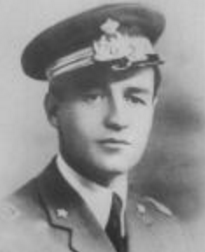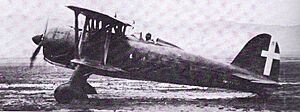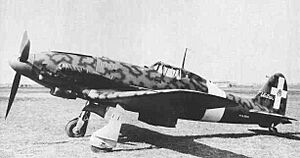Franco Bordoni facts for kids
Quick facts for kids
Franco Bordoni-Bisleri
|
|
|---|---|
 |
|
| Nickname(s) | "Robur" |
| Born | 10 January 1913 Milan, Italy |
| Died | 15 September 1975 (aged 62) Chiavari |
| Allegiance | Italy |
| Service/ |
Regia Aeronautica |
| Years of service | 1937 – 1943 |
| Rank | tenente |
| Unit | 18° Gruppo Caccia - 3° Stormo, Regia Aeronautica |
| Battles/wars | Second World War |
| Awards | Medaglia d'Argento al valor Militare Croce al Merito di Guerra |
Franco Bordoni-Bisleri (born January 10, 1913 – died September 15, 1975) was a brave Italian pilot and a fast racing car driver. He was one of the best "flying aces" of the Regia Aeronautica (the Italian Royal Air Force) during World War II. He achieved 19 air victories. His special nickname was "Robur," which means "strength" in Latin. He often painted this name on his airplanes and racing cars.
Contents
Early Life and Flying Dreams
Franco Bordoni-Bisleri was born in Milan, Italy. His family owned a well-known company that made a special drink. Franco went to a very good private school in Milan. Even when he was young, he was great at driving cars. The idea of flying really excited him because it was so fast!
In 1936, Franco became a civil pilot. He tried to join the Italian Royal Air Force, but a small nose problem made it hard. Finally, in 1937, he was able to join as a temporary officer. This allowed him to get a military flying license and fly important missions during World War II.
Franco's World War II Adventures
When Italy joined the war in June 1940, Franco Bordoni-Bisleri rejoined the Italian Royal Air Force. He was sent to a unit called 95a Squadriglia. He flew in battles against France and later went to Belgium for the end of the Battle of Britain.
He also spent time flying in Libya in North Africa. He remembered his first trip there in August 1940. He returned in January 1941 and stayed until August 1941.
Franco had his nickname "Robur" painted on his plane. He got his first air victory on March 10, 1941. He was flying a Fiat CR.42 and shot down a British Bristol Blenheim bomber. Later, he shot down a Hawker Hurricane fighter plane. Three days later, on April 17, he claimed another Blenheim bomber.
In May, Franco was promoted to Tenente (Lieutenant). He received his first Medaglia d'argento al valore militare (a bravery award) and a German Iron Cross. On June 2, he shot down two more Blenheim bombers. His plane was damaged, but he was safe. For these victories, he received his second Silver Medal.
Franco said that in 1941, the Fiat CR.42 was a good plane. It was easy to fly, strong, and could turn quickly. But it wasn't fast enough and didn't have very strong weapons compared to some enemy planes.
When his unit returned to Italy, they got new planes called Fiat G.50s. Later, they switched to Macchi C.200 Saetta planes.
In October 1942, Franco's unit started getting MC.202s. He said these new planes made a big difference. With them, he could fight against Hawker Hurricanes and P-40s successfully. His number of victories started to grow. On October 20, he claimed a twin-engine bomber.
On October 26, Franco and other pilots attacked many enemy planes, including Kittyhawks and Spitfires. Franco claimed one of the Kittyhawks. On October 30, he claimed another Kittyhawk. On November 1, 1942, he and another pilot attacked 15 P-40s. Franco shot down two P-40s. For this, he received his third Silver Medal of Military Valor.
On November 4, Franco shot down another P-40 that had just hit one of his fellow pilots.
In July 1943, Franco flew a new plane, the Macchi C.205. He shot down a huge B-17 bomber over Rome. On August 11, he shot down two more B-17s. One fell into the sea, and the other fell near a lake.
On August 19, he claimed a B-26 bomber. The next day, he became a flight commander. On August 21, he shot down another B-17. On August 30, he destroyed another B-17 near Viterbo.
Franco got his last air victory on September 5, 1943, just three days before Italy signed an armistice (peace agreement). He shot down another B-17 Flying Fortress.
Franco Bordoni-Bisleri ended the war with 19 victories. He shot down planes like the CR.42s and C.202s. Twelve of his victories were in Libya, and the last seven were American bombers. He shot down six Curtiss P-40s and four Blenheim bombers.
Racing Cars After the War
After the war, Franco became the head of his family's company. He also started a new career as a sports car racing driver. He became one of Europe's top amateur drivers in the 1950s. He continued to use his "Robur" logo, which showed a fighting lion.
He started racing in 1949. In 1950, he won his first race at Monza, driving a Maserati A6. He won more races in 1950 and 1951. In 1952, he won a race in Bari.
In 1953, he became the Italian Sportscar Champion. He won several races that year, including the Coupe de Vitesse and the Pergusa Grand Prix. He won the Pergusa Grand Prix again in 1954.
In 1955, he got to drive for the official Maserati factory team. He raced many different Maserati cars and won his third Pergusa Grand Prix. He continued to race for Maserati for a few more years. His last victory was in 1957. He stopped racing in 1959 when he was 46 years old.
Sad End
Franco Bordoni-Bisleri died in a plane crash on September 15, 1975. He was flying back from an event in Rome. He was the President of the Aero Club of Milan. His ten-year-old son, Franchino, and a friend were with him. They flew into a bad storm near Chiavari, Italy. The plane crashed, and everyone on board died. His death was widely reported in the news at the time.
Awards and Honors
- Silver Medal of Military Valor (three times during World War II)
- Iron Cross 2nd class (1939)
See also
- List of World War II aces from Italy




